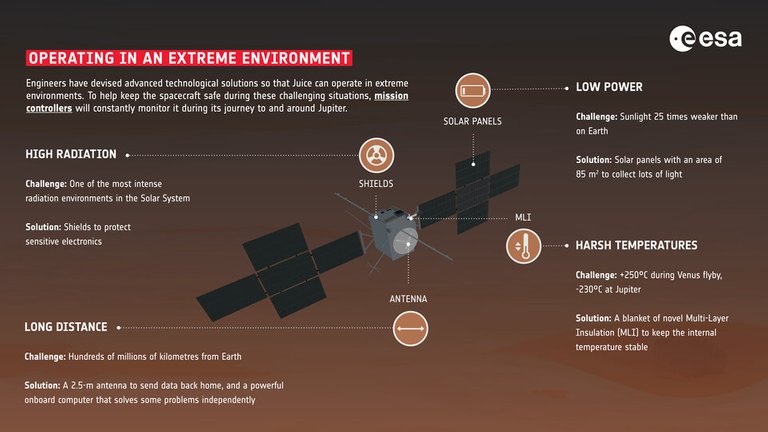The new mission to explore the icy moons of Jupiter
The new mission to explore the icy moons of Jupiter
April 14, 2023 is a new date that must be marked in the exploration of the solar system because that day the new interplanetary mission of the European space agency ESA was launched.

Souce Io (moon)
The spacecraft will visit three of the four large moons discovered by Galileo in 1610, they will be the icy moons of Ganymede, Callisto and Europa, io is the closest Galilean satellite to Jupiter, io is slightly larger than our moon and is left out of exploration because io is a world without ice due to the
io is very dry, it is in proportion the known object of the solar system with the least amount of water and without water there can be no life as we know it

Souce Ganymede
Very different is Ganymede, the largest Moon in the solar system, with its diameter of 5,268 kilometers it is even larger than the Planet Mercury, it is the only known Moon that has a magnetic field, for which reason it is suspected that it has a cast iron core. in a similar way to what happens with the earth.

Souce Callisto
Callisto is a little-known moon but it also has the size of a small planet, since it has a diameter of 4,879 kilometers, almost the same as that of the Planet Mercury, it is the third satellite in size of the solar system, only surpassed by Ganymede and Saturn's large moon Titan is also suspected of having a global ocean beneath its icy surface, but Callisto's crust would be the thickest of the three moons to explore.

Souce Europa
And it is that the radiation and the lack of a protective magnetic field would make life impossible on the surface of Europa, it would even make it very difficult to establish a permanent base there unless it was extremely shielded, it is estimated that a human being exposed to such radiation level on the surface of the moon Europa, you would develop a serious illness or even death in just 24 hours, but under the icy crust of Europa, the thinnest of the three icy moons to be explored, things change and a lot , Radiation does not reach there and a great global ocean extends.

Souce
Over the next two and a half weeks the spacecraft will deploy its various antennas and instrument arms, including the 16-meter-long radar antenna, the 10.6-meter-long magnetometer arm, and other scanning instruments, now beginning a 8-year journey with four gravity-assisted flybys of the earth and Venus in order to gain momentum and launch the spacecraft towards the system of moons or rather small worlds that orbit Jupiter, the largest of the planets in the solar system.
Thank you for visiting my blog. If you like posts about #science, #planet, #politics, #rights #crypto, #traveling and discovering secrets and beauties of the #universe, feel free to Follow me as these are the topics I write about the most. Have a wonderful day and stay on this great platform :) :)
! The truth will set us free and science is the one that is closest to the truth!
0
0
0.000
Thanks for your contribution to the STEMsocial community. Feel free to join us on discord to get to know the rest of us!
Please consider delegating to the @stemsocial account (85% of the curation rewards are returned).
You may also include @stemsocial as a beneficiary of the rewards of this post to get a stronger support.